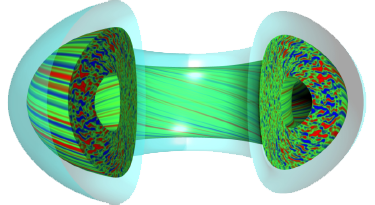Speaker
Description
The ITER Integrated Modeling and Analysis Suite (IMAS) is utilized in this research to develop a generalized approach to transport model implementation in the TRANSP code [1]. Similar to the efforts in the European Transport Simulator (ETS) [2], the transport models in TRANSP will communicate with all other components through the Interface Data Structures (IDSs) that are defined in the IMAS Data Model. The Multi-Mode Model (MMM) v8.2 [3] for anomalous transport has been selected for testing and initial implementation of the new interface to IDSs. The core_profiles and equilibrium IDSs are used to initialize the model, and the core_transport and gyrokinetic IDSs are used for the model output. Using these three IDSs, the MMM v8.2 model communicates with other relevant modules such as the equilibrium and transport solvers. In this work, we also demonstrate how to utilize the new IMAS interface for the stability analysis of experimental data and for the neural network development for MMM v8.2. For these tasks, the experimental data and kinetic equilibrium reconstructions come from the OMAS interface in OMFIT [4], which is connected to several experimental databases. This capability provides an opportunity to test the IMAS interface for anomalous transport models using the experimental data from several tokamaks until direct IMAS plugins for these tokamaks are developed. The experimental data are being saved in a local IMAS database and retrieved by a standalone MMM v8.2 driver program. The stability analysis of experimental data and neural network model development can be substantially accelerated with this workflow.
- J. Ongena, M. Evrard, D. McCune, Numerical Transport Codes, in the Proceedings of the Third Carolus Magnus Summer School on Plasma Physics, (Spa, Belgium, Sept 1997), as published in Transactions of Fusion Technology, March, 1998, 33 No. 2T, pp. 181-191.
- P. Strand, J. Ferreira, A. Figueiredo, P. Huynh, T. Jonsson, E. A. Lerche et al. (2018). Towards a Predictive Modelling Capacity for DT Plasmas: European Transport Simulator (ETS) Verification and Validation. Presented at 27th IAEA Fusion Energy Conference (FEC 2018), Gandhinagar.
- T. Rafiq, A.H. Kritz, J. Weiland, A.Y. Pankin, L. Luo, Physics basis of Multi-Mode anomalous transport module, Phys. Plasmas 20 (2013) 032506.
- O. Meneghini, S.P. Smith, L.L. Lao, O. Izacard, Q. Ren, J.M. Park, J. Candy, Z. Wang, C.J. Luna, V.A. Izzo, B.A. Grierson, P.B. Snyder, C. Holland, J. Penna, G. Lu, P. Raum, A. McCubbin, D.M. Orlov, E.A. Belli, N.M. Ferraro, R. Prater, T.H. Osborne, A.D. Turnbull, G.M. Staebler, and the AToM Team [Integrated Modeling Applications of Tokamak Experiments with OMFIT] Nuclear Fusion 55 (2015) 083008.
| Country or International Organisation | United States of America |
|---|---|
| Affiliation | Princeton Plasma Physics Laboratory |

